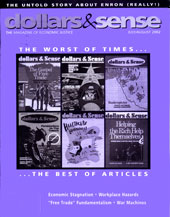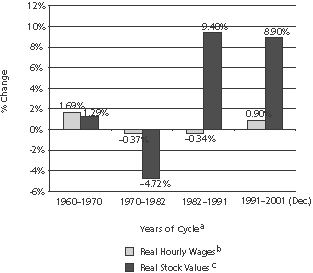"The 1990s, the Decade of the Worker"
Business Week's April Fool's Joke
This article is from the July/August 2002 issue of Dollars and Sense: The Magazine of Economic Justice available at http://www.dollarsandsense.org

This article is from the July/August 2002 issue of Dollars & Sense magazine.
Subscribe Now
at a discount.
The biggest winners of the 1990s were workers, not investors. That is the punch line of "Restating the '90s," Michael Mandel's cover story in the April 1, 2002, edition of Business Week.
No, it is not an April Fool's joke. Mandel is quite serious. First, according to his article, workers made out big during the 1990s—especially in comparison with the 1980s—while investors and owners of corporations suffered through a decade that offered them lower returns than did the 1980s. Second, as Business Week calculates it, 99% of the productivity gains of the 1990s went to workers, in the form of either increased compensation or new jobs, denying owners of corporations "their fair share of the gains."
As Suspect as They Sound
But closer inspection reveals that both claims are as suspect as they sound. Let's start with the better-than-the-1980s gambit.
It's true that the 1990s brought lower unemployment rates and better wage growth than the 1980s, and that workers' purchasing power continued to improve even during the 2001 recession. Should workers be happy about that? You betcha. But when we go back a little further, it's hard to conclude that workers prospered at the expense of investors.
First off, even though gains in real hourly wages of non-supervisory workers during the 1990s business cycle—0.90% annually—compare favorably with the 0.34% annual decline posted during the 1980s cycle (and the even worse beating workers' purchasing power took during the 1970s), they were still just over one-half of the wage gains that workers enjoyed during the 1960s cycle. (See chart.) Also, despite workers' real wage gains during the 1990s boom, at the end of the decade their purchasing power remained far below that of workers 30 years ago.
Annual Wage and Stock Value Change
During the 1960s, 1970s, 1980s, and 1990s Business Cycles

a For the 1960s, 1980s, and 1990s, the dates in the table correspond roughly to the beginning and ending dates of the business cycle. The 1970s numbers are provided for comparison but cover two different business cycles, not one.
b Calculated as the annual percentage increase in hourly earnings of non-supervisory workers in constant 1982 dollars.
c Calculated as the annual percentage increase in the Standard and Poor's Composite Index, excluding dividends, and corrected for inflation using the Consumer Price Index.
Sources: Economic Indicators, April 2002; Economic Report of the President, 1963, 1971, 1984, 1993, 2002.
How did investors fare? Stock market returns (adjusted for inflation) in the 1990s—including the last couple of years of the decade, when the market fizzled—didn't quite match the unprecedented gains of the 1980s. But those returns still far outdistanced the returns of the 1960s. (In the 1970s, real stock values declined.) (See chart.)
Neither finding seems to warrant "restating the '90s" as the decade of the worker instead of the investor. The real returns to stock investors during the 1990s far exceeded the gains in real hourly wages. Only during the 1960s —not the 1970s, 1980s, or 1990s—did gains in real hourly wages surpass those of stock investors.
What about Business Week's second assertion: that workers received 99% of the gains from faster productivity growth in nonfinancial corporations during the 1990s, therefore denying owners of corporations "their fair share"? That is suspect as well.
According to Business Week, productivity gains during the 1990s added $812 billion (in 2001 dollars) to the decade's output. After massaging the data, author Mandel shows a whopping $806 billion of the gains going to workers. But in figuring workers' gains, Business Week counts not only wage increases but also gains "in the form of more jobs and higher compensation, including exercised stock options." While more jobs do help the unemployed, they don't add to the compensation of workers who already hold jobs. Also, much of those compensation gains came from the increased cost of benefits, especially health benefits. Finally, including stock options underlines the fact that Business Week's definition of "worker" includes upper-level management, including CEOs. And CEOs surely did make out during the 1990s: An earlier Business Week study found that the average CEO of a major corporation made 85 times the average hourly worker's pay at the beginning of the decade, and a staggering 531 times by the end of the decade.
What about other corporate investors? Based on Business Week's formulation, you might think that corporate profits increased by just $6 billion during the 1990s. Far from it. Business Week actually puts the figure at $559 billion—"a truly striking performance," according to Mandel. However, Mandel says that those increased profits came about, not because of productivity gains, but "mainly because companies paid lower interest rates on debt." Since lower interest rates reduce returns for bond investors, who often also own stock (and thereby corporations), Mandel refuses to count those savings as gains for owners of corporations. Deducting the savings in interest costs leaves owners of corporations with just $6 billion in profits due to productivity gains.
But the truth is, it's impossible to know the source of that $559 billion in corporate profits. The profits could just as well have come from savings due to productivity gains as from savings from lower interest costs—or, for that matter, from other sources, like savings from lower inventory costs or lower prices for imported raw materials.
But let's suppose that workers really did see $806 billion in additional compensation during the 1990s, while owners of corporations got $559 billion in new profits during the decade. Would that make the 1990s the decade of the worker?
Not hardly. Even allowing for Business Week's broadest possible interpretation of gains to workers, owners of corporations would have enjoyed an 83.6% increase in their profits over the decade, while workers would have seen the monies coming their way increase by just 13.6%. Owners of corporations would still be the big winners of the 1990s.
Inequality Worsens
| Household | Income Range (in 2000) | Share of Aggregate Income | |||
| 1970 | 1980 | 1990 | 2000 | ||
| Lowest Fifth | < $17,955 | 4.1% | 4.3% | 3.9% | 3.6% |
| Second Fifth | > $17,955 but < $33,006 | 10.8% | 10.3% | 9.6% | 8.9% |
| Third Fifth | > $33,006 but < $52,272 | 17.4% | 16.9% | 15.9% | 14.9% |
| Fourth Fifth | > $52,272 but < $81,960 | 24.5% | 24.9% | 24.0% | 23.0% |
| Highest Fifth | > $81,960 | 43.0% | 43.7% | 46.6% | 49.6% |
| Top 5% | > $145,526 | 16.6% | 15.8% | 18.6% | 21.9% |
| Source: U.S. Bureau of the Census, Historical Tables H-1 and H-2. | |||||
If the 1990s had really been the decade of the worker, then surely household incomes would have become more equal. But they did not. Instead, the gap between rich and poor continued to widen, both because the wage differences between low- and high-wage workers increased, and because investors enjoyed gains in income not matched by those who worked for wages. By the end of the 1990s, economic inequality had reached levels well beyond those of the 1980s. In the year 2000, 49.6% of aggregate income went to the richest 20% of households, and well over one-fifth of aggregate income went to the top 5%, those with incomes in excess of $145,526. (See table.)
Perhaps someday there will come a decade when 99% of productivity gains truly go to workers and the gaping inequalities in household income are reversed. But the 1990s wasn't it. Should the current decade reward workers with the lion's share of productivity gains, we at Dollars & Sense will gladly run a cover story declaring it "the decade of the worker," and sit back, along with everyone else, to enjoy the fruits of our labor.
